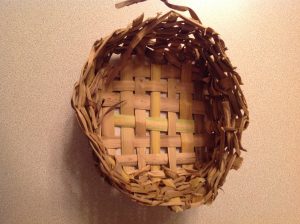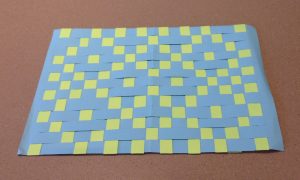Bulrush Weaving:

This very tactile weaving experience began with a “field trip” where we ventured out of our art lab and over to the garden outside the Museum of Biodiversity. Our guest instructor, Dr. Susan Jerofsky, had gotten permission to cull some of their bulrush plants. We gathered good sized bundles of the rushes by simply cutting them with scissors. The bundles were dried for the next three weeks. The morning of our weaving class, Dr. Miller submerged the rushes in water, re-hydrating them so that they would be pliable for us to work with. This drying of fresh materials and then subsequent re-hydration is typical of many natural weaving materials (straw and other grasses).
Dr. Jerofsky then showed us how to weave the rushes in an over/under and spiral pattern. We also learned about twining as a way to hold our weaving in place. Twining involves twisting the rush after each over and under. In my sample, I also added a few wooden beads for embellishment. I really like the overall product and effect.
I also attempted weaving a bulrush box and I was pretty pleased with how well it went, for a first try (although I was unable to finish off the top of the box in class time and it will be too brittle to manipulate when I go back to it next week).
I liked how we really went back to nature with this experience. We used traditional methods and local, unprocessed materials to create something so pretty. It is enjoyable to reconnect with our environment and also to use methods of creating containers, matting, decorations, that have been used for thousands of years. I helps me to appreciate the depth, expertise and creativity of our early ancestors. It is also satisfying because it is a sustainable process that does not rely on harsh chemicals, pigments, or dyes to make something useful and beautiful.
I’d really like to do this with my students. It is very much a level that they can enjoy and also be challenged by in grade 4/5. It also will connect us to the studies that we do on the First Nations peoples of the West Coast.

Paper weaving samples:


Cardboard Loom Weaving:
For this project, I used a cardboard loom. For the warp (the up and down strings) I wound cotton string around the incisions cut into the edges of the cardboard. The weft was flat blue yarn I had at home, that was verigated in colour. I unwound the yarn and separated it into dark, medium and light hues. Then I set work creating (my go to) water, mountains and sky.
